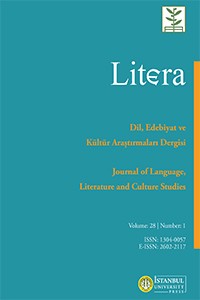Abstract
Bu çalışma, David Mitchel ve Sharon Synder’in ‘engellilik çalışmaları’ şemsiyesi altında tanıtılan anlatı protezi bağlamında, postmodern İngiliz oyun yazarı Martin McDonagh tarafından yazılan kayda değer oyunlarından Yastık Adam’ı incelemeyi amaçlar. Çalışma, Mcdonagh’ın bahsi geçen oyunundaki karakterleri edebi özelliklerine göre, engellilik çalışmalarındaki bedensel/mental “normallik” ve “engellilik” kavramlarıyla ilişkili olarak inceler. Bu bağlamda, çalışma, McDonagh’ın oyunun anlamsallığını artırmasını sağladığı ‘engelli’ karakterlerin ‘varoluşçu’ yönlerinin yanında, anomali siyaseti ve anlatı ve engellilik ilişkisine dair sonuçlar etrafında döner. Makale, anlatı protezi kavramı ve engelliliğin doğasını, politiğini ve sonuçlarını kültürel, sosyal ve edebi bir yapı olarak inceleyip entelektüel bir disiplin olarak ifade edilen ve güncel bir yaklaşım olan kritik engellilik çalışmaları üzerine bir dizi yorumu içerir. Bu nedenle bu makale, anlatı protezinin, oyun ve ilgili eserlerdeki referanslara odaklanarak yazar-oyun ilişkisi yoluyla uygulanabilirliğini bulmaya çalışır. Bu bağlamda, bu makale McDonagh’ın ‘engelli’ karakterler ile olgunlaşan oyununu da ‘kültürel ve edebi yatırım’ objektifinde inceleyecektir.
References
- Barthes, R. (1975). The pleasure of the text. New York, NY: Hill and Wang.
- Hall, A. (2016). Literature and disability. New York, NY: Roultedge.
- Higl, A. (2012). Playing the canterbury tales: The continuations and additions. Surrey, UK: Ashgate.
- Higl, A. (2016). Henryson’s textual and narrative prosthesis onto chaucer’s corpus: Ceresseid’s leprocy and her schort conclusioun. In J. R. Eyler (Ed.), Disability in the middle ages: reconsiderations and reverberations (pp. 167-181). New York, NY: Routledge.
- Johnston, K. (2016). Disability theatre and modern drama. London, UK: Bloomsbury.
- Lawrence, L. J. (2013). Sense and stigma in the gospels: Depictions of sensory-disabled characters. Oxford, UK: Oxford University Press.
- Lennard J. D. (1995). Enforcing normalcy: Disability, deafness and the body. London, UK: Verso.
- McDonagh, M. (2003). The pillowman. London, UK: Dramatists Play Service Inc.
- Mitchell, D., & Synder, S. (2000). Narrative prosthesis: Disability and the dependencies of discourse. Ann Arbor, Michigan: University of Michigan Press.
- Mitchell, D., & Synder, S. (2006). Narrative prosthesis and the materiality of metaphor. In L. J. Davis (Ed.), The disability studies reader (pp. 205-216). New York, NY: Routledge.
- Mitchell, D., & Synder, S. (2006). Cultural locations of disability. London, UK: The University of Chicago Press.
- Titchkosky, T. (2016). The politics of embracing disability metaphor. In C. Kelly & M. Orsini (Eds.), Mobilizing metaphor: Art, culture, and disability activism in Canada. Toronto, Ontario: UBC Press.
Abstract
This study aims to examine The Pillowman—a noteworthy play written by the postmodern British playwright Martin McDonagh—in the context of the narrative prosthesis introduced by David Mitchel and Sharon Synder under the umbrella term ‘disability studies’. The study examines the characters in Mcdonagh’s play in terms of their literary characteristics in relation to the concepts of ‘normalcy’ and ‘disability’ within disability studies. In this context, the study revolves around McDonagh’s creation of ‘existential’ aspects of ‘disabled’ characters which has implications for the meaning of the play, the politics of the anomaly, and the narrative and disability relationship. The article explains the concept of narrative prosthesis as well as a number of interpretations on Critical Disability Studies, a current approach which is an intellectual and educational discipline studying the implication, nature, and consequences of disability as a cultural, social and literary construct. For this reason, this article tries to find out the applicability of the narrative prosthesis through the author-play relationship focusing on references from the play and related works. In this respect, this article will also examine McDonagh’s play, which is enriched by ‘disabled’ characters, in the lens of ‘cultural and literary investment’.
References
- Barthes, R. (1975). The pleasure of the text. New York, NY: Hill and Wang.
- Hall, A. (2016). Literature and disability. New York, NY: Roultedge.
- Higl, A. (2012). Playing the canterbury tales: The continuations and additions. Surrey, UK: Ashgate.
- Higl, A. (2016). Henryson’s textual and narrative prosthesis onto chaucer’s corpus: Ceresseid’s leprocy and her schort conclusioun. In J. R. Eyler (Ed.), Disability in the middle ages: reconsiderations and reverberations (pp. 167-181). New York, NY: Routledge.
- Johnston, K. (2016). Disability theatre and modern drama. London, UK: Bloomsbury.
- Lawrence, L. J. (2013). Sense and stigma in the gospels: Depictions of sensory-disabled characters. Oxford, UK: Oxford University Press.
- Lennard J. D. (1995). Enforcing normalcy: Disability, deafness and the body. London, UK: Verso.
- McDonagh, M. (2003). The pillowman. London, UK: Dramatists Play Service Inc.
- Mitchell, D., & Synder, S. (2000). Narrative prosthesis: Disability and the dependencies of discourse. Ann Arbor, Michigan: University of Michigan Press.
- Mitchell, D., & Synder, S. (2006). Narrative prosthesis and the materiality of metaphor. In L. J. Davis (Ed.), The disability studies reader (pp. 205-216). New York, NY: Routledge.
- Mitchell, D., & Synder, S. (2006). Cultural locations of disability. London, UK: The University of Chicago Press.
- Titchkosky, T. (2016). The politics of embracing disability metaphor. In C. Kelly & M. Orsini (Eds.), Mobilizing metaphor: Art, culture, and disability activism in Canada. Toronto, Ontario: UBC Press.
Details
| Primary Language | English |
|---|---|
| Subjects | Creative Arts and Writing |
| Journal Section | Research Articles |
| Authors | |
| Publication Date | June 22, 2018 |
| Submission Date | April 15, 2018 |
| Published in Issue | Year 2018 Volume: 28 Issue: 1 |


